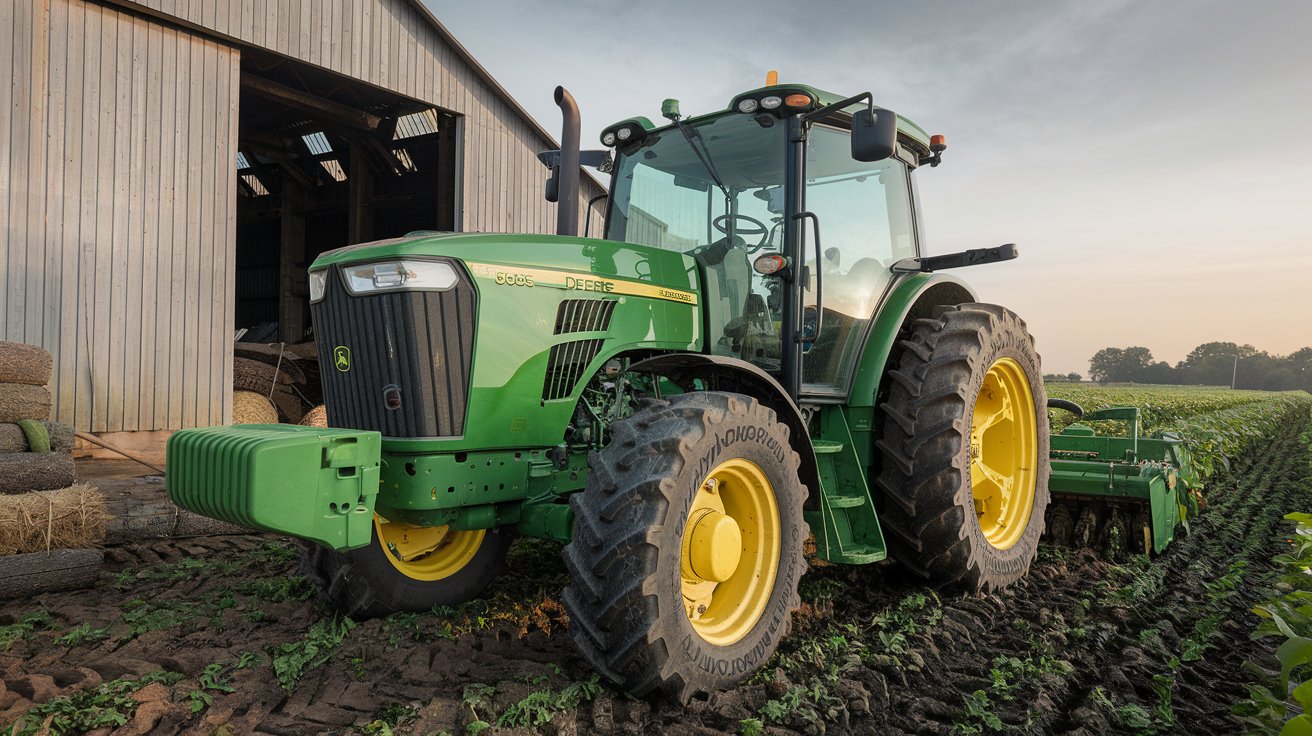The John Deere 5065E is a dependable tractor, but like any machine, it can encounter issues such as overheating, hydraulic failures, electrical malfunctions, or transmission troubles. Proper maintenance, like cleaning radiator fins to prevent overheating or regularly checking hydraulic seals, can keep the tractor running smoothly. Electrical problems, like battery or alternator issues, are common but usually easy to fix with routine inspections. Transmission and PTO failures typically result from worn parts like clutches or fluid levels and can be addressed with timely repairs. Engine performance and steering issues also arise if key components are neglected. Following a proper maintenance routine can help prevent these common setbacks and prolong the tractor’s lifespan.
Curious to learn more?
- Discover how to fix steering problems that can disrupt your workflow.
- Find out the best practices for maintaining your tractor’s hydraulic system.
- What’s the secret to handling tricky PTO failures? Let’s explore!
Let’s dive into the most common John Deere 5065E problems and practical solutions for handling them effectively.
1. Overheating Issues
One of the most commonly reported issues with the John Deere 5065E involves overheating. It’s a big concern, particularly during prolonged work periods or in hot climates.
Causes:
- Blocked Radiator Fins: Dust, grass, and dirt clog the radiator fins, reducing airflow.
- Low Coolant Levels: Insufficient coolant leads to poor heat dissipation.
- Faulty Thermostat: A stuck thermostat doesn’t allow coolant to circulate properly.
Solutions:
- Regularly clean the radiator fins with pressurized air or water.
- Maintain proper coolant levels. Always use a coolant recommended by John Deere.
- Replace the thermostat if it’s malfunctioning.
2. Hydraulic System Failures
A tractor’s hydraulic system essentially powers attachments and other functionalities. Unfortunately, the 5065E sometimes faces hydraulic issues.
Symptoms:
- Attachments function sluggishly or not at all.
- Odd noises from the hydraulics.
- Hydraulic oil leaks.
Causes:
- Dirty or Old Hydraulic Fluid: Over time, the oil degrades or collects debris.
- Air in the System: Improper seals or connections can let air into hydraulic lines.
- Faulty Hydraulic Pump: A worn-out pump diminishes performance.
Solutions:
- Change hydraulic oil according to the maintenance schedule and use quality oil.
- Check connections and seals regularly to ensure airtightness.
- If the pump is damaged, get it replaced by a technician or use official John Deere parts.
3. Electrical System Malfunctions
Electrical issues might sound complicated, but they are surprisingly common with this model.
Symptoms:
- Starting problems.
- Dead batteries.
- Inconsistent performance of electrical components.
Causes:
- Loose or Corroded Connections: Terminals and wires loosen over time and collect dirt.
- Faulty Battery: Overused or improperly maintained batteries usually stop holding a charge.
- Damaged Alternator: If the alternator isn’t working, it won’t recharge the battery.
Solutions:
- Regularly inspect and tighten all electrical connections, applying dielectric grease where needed.
- Ensure the battery is properly charged and replace it when its lifespan is up.
- Test the alternator and replace it if necessary.
4. Transmission Trouble
Transmission problems might significantly affect the tractor’s performance and are often a result of poor maintenance or wear and tear.
Symptoms:
- Difficulty shifting gears.
- Noisy operation during gear changes.
Causes:
- Low Transmission Fluid: Insufficient lubrication strains the transmission system.
- Clutch Wear: Prolonged use can wear out the clutch.
- Missing Routine Maintenance: Skipping regular inspections can cause issues to build up unnoticed.
Solutions:
- Frequently check and top up transmission fluid levels.
- Adjust the clutch or replace it if it’s worn.
- Stick to John Deere’s recommended maintenance schedule.
5. PTO Failures
The Power Take-Off (PTO) is essential, especially if you rely on attachments like mowers or balers. Malfunctions in the PTO can disrupt your workflow.
Symptoms:
- PTO not engaging.
- Strange noises when the PTO is operational.
Causes:
- Worn PTO Clutch: Over time, the clutch experiences wear and tear.
- Damaged Linkages: Improper or strained use damages connections.
Solutions:
- Inspect and adjust the PTO clutch if needed.
- Replace damaged linkages or shafts immediately.
6. Fuel System Problems
Symptoms of fuel system issues, such as reduced power or stalling, are fairly common in any tractor but especially frustrating during work.
Causes:
- Clogged Fuel Filters: Dirt and debris restrict fuel flow.
- Air in the Fuel Line: Air pockets impede proper fuel combustion.
- Faulty Injector: A misfiring injector reduces engine performance.
Solutions:
- Regularly replace fuel filters.
- Bleed the fuel lines to remove trapped air.
- Replace injectors if they’re not functioning optimally.
7. Steering Problems
Farmers often report difficulty steering their John Deere 5065E, especially under heavier loads.
Causes:
- Low Hydraulic Steering Oil: An insufficient volume makes steering tough.
- Worn Steering Components: Elements like tie rods or cylinders break down over time.
Solutions:
- Ensure hydraulic steering oil remains at the recommended level.
- Inspect steering components regularly and replace when needed to maintain smooth performance.
8. Engine Starting Problems
A non-starting 5065E can dampen anyone’s day, especially during busy seasons.
Causes:
- Weak Battery: Insufficient power due to age or improper storage reduces cranking power.
- Cold Weather: During winter, cold oil and battery performance hinder ignition.
Solutions:
- Replace the battery periodically for consistent starts.
- Use an engine block heater in colder months.
Routine Maintenance Tips
While fixing problems when they arise is essential, preventive care goes a long way in keeping your tractor running smoothly. Here are some tips to incorporate into your John Deere 5065E maintenance plan:
- Stick to the User Manual: Familiarize yourself with the recommended schedules for oil changes, filter replacements, and hydraulic fluid checks.
- Daily Inspections: Always check for oil leaks, tire pressures, and fluid levels before using your tractor.
- Keep It Clean: Regularly washing the exterior helps prevent mud build-up that could affect cooling systems and moving parts.
- Use Genuine Parts: Investing in original John Deere replacement parts helps maintain compatibility and reliability.
- Train Your Operators: If someone else uses your tractor, ensure they understand its operation and maintenance requirements.
Frequently Asked Questions (FAQs)
Here are some common questions about John Deere 5065E problems and their fixes:
Why does my John Deere 5065E keep overheating?
Overheating usually occurs due to clogged radiator fins, low coolant levels, or a faulty thermostat. Regular cleaning and maintenance can prevent this.
How often should the hydraulic fluid be changed?
Refer to the tractor’s user manual, but typically, changing hydraulic fluid and filters every 500 operating hours is recommended.
What should I do when my 5065E’s electrical system malfunctions?
Check for loose or corroded connections, ensure the battery is properly charged, and test the alternator’s functionality.
Why is my tractor struggling to shift gears?
Difficulty shifting gears is often due to low transmission fluid, clutch wear, or skipped maintenance checks.
How do I prevent air from getting into my hydraulic system?
Inspect seals and connections regularly to ensure they’re airtight and be cautious during fluid changes.
What are the signs of a clogged fuel filter?
Reduced engine power, stalling, or erratic operation can indicate a dirty or clogged fuel filter that needs replacement.
Why won’t my tractor’s PTO engage?
This could be due to a worn PTO clutch or damaged linkages, both of which should be inspected and replaced if necessary.
How can I boost starting performance in winter?
Use an engine block heater and ensure your battery is in peak condition to handle cold weather.
What steering issues are common with the John Deere 5065E?
Common steering problems stem from low hydraulic oil or worn steering components like tie rods and cylinders.
Can I use aftermarket parts for repairs?
While aftermarket parts are available, it’s recommended to use genuine John Deere parts for compatibility and durability.
Final Thoughts
Every machine has its quirks, and the John Deere 5065E is no exception. However, most issues, whether it’s overheating, hydraulic failures, or electrical glitches, can be prevented or solved with routine upkeep and diligence. Over time, knowing your tractor and spotting small issues before they worsen can save time, money, and frustration.
The beauty of the John Deere 5065E lies in its durability. By addressing problems proactively and sticking to a strict maintenance regime, you can rest assured that this faithful workhorse will serve you for years to come!

